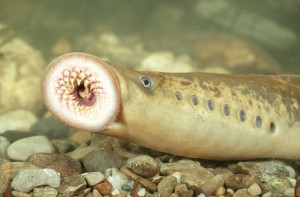Monster Monday: the Lurid Lamprey
October 10, 2016
The lamprey is an animal of contradictions. It looks like a leech, but it’s actually a fish. Some adult lampreys suck blood, but others don’t eat at all. Some kinds are invasive, but others are threatened. What is abundantly clear, however, is that the lamprey has a face only a mother could love.
A lamprey is any of a group of fish with long, slender bodies and a round mouth with no jaws. Scientists consider the lamprey among the least developed vertebrates (animals with backbones) because it has maintained the same body plan for hundreds of millions of years. It has no bones; it instead has a flexible notochord made of rubbery tissue called cartilage running down the length of its back. A lamprey has fins on its back but not on its sides. A lamprey’s skin is smooth, shiny, and scaleless. All lampreys are dull colored, ranging from light tan to brownish- or bluish-black. They do not have true bony teeth. Their teeth are horny developments that grow from the inner surface of the mouth.
Different species (kinds) of lampreys live in lakes, rivers, and oceans. Ocean lampreys are the largest, growing as long as 3 feet (90 centimeters). Larval (young) lampreys have a significantly different diet than that of adults. They live in the sand and mud of stream bottoms for several years, filtering out tiny organisms from the water with their toothless mouths. Over time, they change into adults, developing eyes and teeth.
Adults of some lampreys are parasitic. They feed by attaching themselves to fishes, scraping a hole through the skin, and sucking out blood. An attacking lamprey buries its toothlike spikes in a fish’s flesh and forms a suction seal around the wound. Glands in the lamprey’s mouth secrete a substance that prevents the wound from clotting. After several hours, the lamprey detaches from its victim and swims away to digest its meal. The victimized fish is not killed, but it may die later from factors indirectly related to the wound. Harmful bacteria may colonize the wound and cause infection. Blood loss also weakens the fish, making it easy prey for predators.
Adults of other species of lampreys are more directly carnivorous (flesh-eating). Like a parasitic lamprey, a carnivorous lamprey swims up to a fish and latches onto it with its circular mouth. Rather than lap up blood, however, it eats through the fish’s flesh with its rasping tongue. The lamprey often gouges down to the bones, and the fish dies quickly.
The adults of a third group of lampreys do not eat at all. When they mature, their digestive organs degenerate, and they live only until the spawning season. After they spawn (reproduce), they die.
Habitat change brought about by humans has benefited some species of lampreys, while harming others. In the 1950’s and 1960’s, parasitic sea lampreys from the North Atlantic Ocean invaded the Great Lakes in central North America through locks and shipping canals. Fish species in the Great Lakes had not evolved (changed over time) in the presence of the lamprey, so they were more susceptible to the harmful effects of the lamprey’s parasitism. Over a few short years, fish populations of the Great Lakes plummeted to a fraction of their original level. Other species of lampreys, such as the nonparasitic American brook lamprey and the parasitic Pacific lamprey, are themselves threatened by habitat degradation from invasive species, shoreline development, and water pollution. Careful land and waterway management is needed to keep each species of lamprey healthy—and where it belongs.



